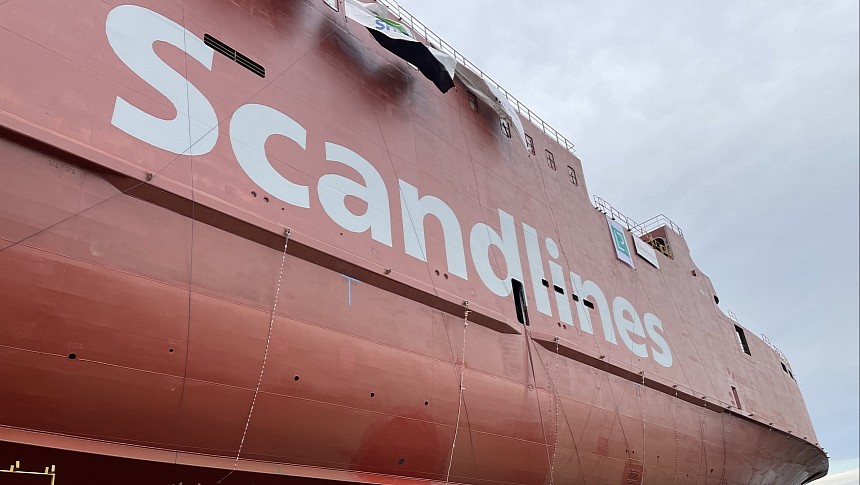Good news for folks traveling between Germany and Denmark – the first zero-emission ferry in the area is gearing up for commercial service, paving the way for a future green ferry fleet. It's named Futura and will start operating in 2024.
Scandlines sees ferries as an efficient alternative to diesel-powered means of transportation, which could benefit tourists, freight drivers, and families going on vacation. Two years ago, the venerable ferry operator (its history dates back to the 19th century) announced plans to replace its existing fleet with a new generation of hybrid-electric vessels.
It took two years and a €80 million investment to bring the first unit to life. It's called Futura, and it was officially launched at the Cemre shipyard in Turkey. Futura will be the first of its kind to start operating on the Puttgarden - Rodby route in 2024.
The route connects Germany to Denmark and is known as a busy ferry route. Until it officially kicks off commercial service, the new ship will also make a stop in Denmark for the installation of a state-of-the-art high ferry charger tower.
This charger tower, made by the German company Stemmann Technik, is 8.6 meters high (28 feet) and functions automatically. It will allow Futura to recharge as fast and smoothly as possible when docked. Futura was designed for a 12-minute charging time in port.
The ship itself is a little over 147 meters (485 feet). In terms of capacity, it can carry up to 140 passengers or 66 trucks or other freight units – this alone is an impressive increase of more than 20% compared to the operator's current ferry capacity on the same route.
Futura boasts a 10 MWh energy storage system, claiming to be the world's largest lithium-ion battery bank. It was supplied by the Swiss expert Leclanche, and it will enable Futura to cover the route in one hour without any emissions. The ferry was also equipped to operate as a hybrid vessel with the help of three MTU units. In hybrid mode, it will be able to complete the same route in 45 minutes, cruising at 16 knots ((18.4 mph/29.6 kph).
The Danish operator intends to replace its entire fleet with hybrid-electric ferries like Futura in the near future. Last year, Scandlines helped transport more than six million people, 1.6 million cars, and 750,000 freight units across two major routes. In total, it completed 39,000 departures on seven ferries.
Once all of those seven ferries are replaced by hybrid-electric versions, their green operations could effectively eliminate a huge amount of emissions on a yearly basis. Scandilines is one of the pioneers, and other ferry operators are sure to follow in its footsteps and start operating a new generation of ships for clean transportation.
It took two years and a €80 million investment to bring the first unit to life. It's called Futura, and it was officially launched at the Cemre shipyard in Turkey. Futura will be the first of its kind to start operating on the Puttgarden - Rodby route in 2024.
The route connects Germany to Denmark and is known as a busy ferry route. Until it officially kicks off commercial service, the new ship will also make a stop in Denmark for the installation of a state-of-the-art high ferry charger tower.
This charger tower, made by the German company Stemmann Technik, is 8.6 meters high (28 feet) and functions automatically. It will allow Futura to recharge as fast and smoothly as possible when docked. Futura was designed for a 12-minute charging time in port.
The ship itself is a little over 147 meters (485 feet). In terms of capacity, it can carry up to 140 passengers or 66 trucks or other freight units – this alone is an impressive increase of more than 20% compared to the operator's current ferry capacity on the same route.
Futura boasts a 10 MWh energy storage system, claiming to be the world's largest lithium-ion battery bank. It was supplied by the Swiss expert Leclanche, and it will enable Futura to cover the route in one hour without any emissions. The ferry was also equipped to operate as a hybrid vessel with the help of three MTU units. In hybrid mode, it will be able to complete the same route in 45 minutes, cruising at 16 knots ((18.4 mph/29.6 kph).
The Danish operator intends to replace its entire fleet with hybrid-electric ferries like Futura in the near future. Last year, Scandlines helped transport more than six million people, 1.6 million cars, and 750,000 freight units across two major routes. In total, it completed 39,000 departures on seven ferries.
Once all of those seven ferries are replaced by hybrid-electric versions, their green operations could effectively eliminate a huge amount of emissions on a yearly basis. Scandilines is one of the pioneers, and other ferry operators are sure to follow in its footsteps and start operating a new generation of ships for clean transportation.








